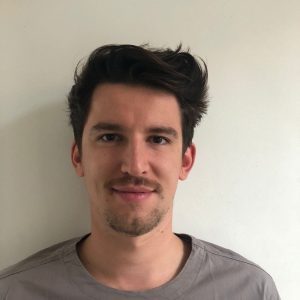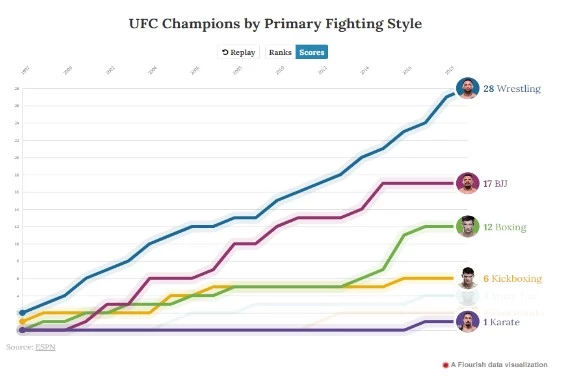

Primary Fighting Styles
Mixed martial arts is in many ways self-explanatory; a mixture of multiple combat styles all rolled into one. The sport started as a clash of styles, often with opponents of starkly contrasting skills facing off against one another.
In fact at UFC 1, Royce Gracie’s incredible Jiu-Jitsu skills were so new and innovative that even the referee didn’t notice his opponent Ken Shamrock tapping out!
Those days are long gone. The game has changed!
Alongside the mainstream rise of UFC, MMA has evolved beyond recognition. Elite contenders now need to be extremely well-rounded – genuine ultimate fighters, if you like – with a strong level of expertise in many different disciplines.
- Wrestling
- Brazilian Jiu Jitsu
- Boxing
- Muay Thai and kickboxing
- Taekwondo
- Judo
- Karate
For enthusiasts looking to engage with the sport beyond just watching, you can explore betting options on crypto sportsbooks, which allow you to place your bets using cryptocurrencies.
UFC Scoring Criteria
To put these varying styles into a betting context, it’s helpful to understand how UFC bouts are scored. As per the official unified rules of MMA, there are 4 key criteria judges should prioritize when awarding points:
➡️ Effective striking: how many legal strikes are landed – relevant for boxing, Muay Thai, karate and taekwondo.
➡️ Effective grappling: how many successful takedowns or reversals are achieved – relevant to wrestling and judo.
➡️ Effective aggressiveness: has a fighter shown effective aggressive attempts to finish the fight – this is style agnostic.
➡️ Fight area control – Who’s dictating the pace, location and positions in the cage? The fighter moving forward to corner his opponent is rewarded here – this one might seem agnostic, but wrestling is all about dictating the pace and controlling areas.
So, there are specific ways that 6 of the 7 primary fight styles can impact and influence the judges’ scorecards.
The single exception is Jiu Jitsu, but this discipline is almost solely responsible for submissions, which make up nearly 40% of UFC stoppages.
The Evolution of MMA Fighting Styles in the UFC
Mixed martial arts (MMA) has come a long way since its inception, and over the years, fighters have adapted their techniques and strategies to become more well-rounded and versatile in the cage. This has led to the development of various fighting styles that are now prevalent in the sport, and these include:
✨ Strikers
Strikers are fighters who excel in striking techniques, using punches, kicks, knees, and elbows to damage their opponents. In the early days of the UFC, many strikers came from traditional martial arts backgrounds such as karate, taekwondo, boxing, or Muay Thai.
These fighters often relied heavily on their striking prowess to score knockouts or win by decision. Over time, however, strikers in the UFC had to evolve to become well-rounded athletes. Otherwise, they’d risk being at a disadvantage when facing grapplers or fighters who would take fighting to the canvas.
- Some notable strikers who have impacted the sport include Anderson Silva, Conor McGregor, Israel Adesanya, and Dustin Poirier, known for their striking acumen and strong grappling skills.
✨ Grapplers
Grapplers specialize in taking their opponents to the ground, controlling them, and attempting to finish the fight via submission. Wrestlers also made their mark in the sport, utilizing their takedown abilities to control and wear down their opponents, which would help them win rounds as player stamina would decrease significantly.
However, grapplers must incorporate striking and standing fighting into their arsenal as the sport evolves to adapt to the striker-type fighter’s precision and force.
- Fighters like Khabib Nurmagomedov and Georges St-Pierre are known grapplers but possess effective striking skills.
However, today fighters who take the fight down to the canvas are more versatile and can trade strikes with their opponents while standing.
✨ All-Rounder
All-rounders excel in all aspects of MMA, combining striking, grappling, and wrestling techniques to create a complete fighting style. These fighters are often the most difficult to prepare for, as they can adapt their approach based on their opponent’s strengths and weaknesses.
- Notable all-rounders, including Jon Jones, Kamaru Usman, Jose Aldo, and Anderson Silva, have shown their ability to combine all fighting styles and dominate a specific weight class for years!
The rise of freestyle fighters in the UFC shows how the sport is evolving, and no one style fits all in combat sports.
Wrestling Superiority
It is wrestling that rules the roost, since wrestlers who transition to MMA can score points inside the octagon using the core moves that come naturally to them.
After all, wrestling is all about controlling your opponent. Achieve a takedown to the mat, and you get points in MMA. Control your opponent and keep them pinned, and you get even more points.
Add to that the fact wrestlers are used to endurance battles and are purpose-built for a combination of speed and strength, and there’s little doubt you have a primary fighting style that is ideal for MMA competition.
Indeed, a glance at the ESPN graph below, tells a compelling story – collated from a gigantic dataset of 21 years of UFC fights, between 1997-2018.

What Makes a Good UFC Fighter?
To be a successful UFC fighter requires a unique blend of qualities that sets apart the good from the greatest fighters to ever live! So let’s see what it takes for fighters to compete at the highest possible level.
1️⃣ Skillset
A well-rounded skillset is crucial for success in the UFC, as fighters must master not one but a few martial arts disciplines.
Imagine being a great boxer but being submitted each time during a grappling exchange. Thus, fighters must master a single discipline, like striking or grappling, and be extremely comfortable with the others. A diverse skillset allows fighters to adapt to different opponents and situations inside the octagon, giving them a competitive edge.
- One such example is Khabib Nurmagomedov, known for his exceptional grappling technique that would tire and subdue his opponents and his ability to go head-to-head in striking exchanges. A mix of skills helped Khabib go undefeated in the UFC and claim UFC gold by beating some of the best in his division!
2️⃣ Mental Toughness
Mental toughness is often considered one of the most critical factors in a fighter’s success, including the fighter’s ability to stay focused, composed, and resilient in high-pressure situations.
Being mentally tough means thinking clearly when wobbling and having the strength to overcome fear and doubt, especially when a player’s odds are against him!
- One example is Connor McGregor who was able to come back and overcome injury and other adversities and become a two-division champion.
3️⃣ Work Ethic
With a strong work ethic, everything is possible. However, talent can easily be wasted if time is not spent preparing and exercising to improve their skill and conditioning. This helps players develop a strong fighter IQ.
There are countless instances where great talent is wasted due to the lack of dedication and commitment to the ultimate goal. But, finally, by working harder than others, players can overcome their opponents in one-on-one combat, thinking ahead of the curve and being one step ahead!
- One such example is Jon Jones, who was stripped of his titles several times, but each time, through hard work, he came back and became champion in Light Heavyweight and recently in the Heavyweight after being sidelined for more than two years.
4️⃣ Adaptability
Adapting and evolving are crucial in the ever-changing landscape of MMA. Fighters who can recognize their weaknesses, learn from their mistakes, and make necessary adjustments are more likely to have long and successful careers in the UFC.
Adaptability also involves adjusting strategies and techniques during a fight, capitalizing on an opponent’s vulnerabilities.
Which Martial Art has the Most UFC Champions?
One of the most prominent martial art disciplines that has shown to produce more UFC champions in recent years than any other sub-category is wrestling in combination with Brazilian Jiu-Jitsu. While Jiu-Jitsu is an advanced version of grappling which leads to more submissions on the ground, wrestling basics are still key to securing those opportunities.
That’s because wrestling allows fighters to control opponents on the ground and proceed with ground impounds. Taking an opponent to the ground and controlling him with advantageous positions opens the door for better opportunities.
Through wrestling – standing or on the ground, fighters can dictate the fight, tire the opponent, and have the upper hand in future exchanges.
Out of the eight different weight categories in UFC, four of them, including Aljamain Sterling, Alexander Volkanovski, Islam Makhachev, and Jon Jones, have excellent wrestling skills and have competed in wrestling before joining the UFC.
Muay Thai fighters are also predominantly important in MMA. Still, there’s only one champion with a previous track record in kickboxing: Israel Adesanya, who’s been in the Glory Kickboxing circuit before joining the UFC. Leon Edwards is also part of that kickboxing mix, although he has yet to have past incursions with the sport as he went straight for MMA. Fighters have different fighting styles, and they excel in having precise strikes and clinching effectively while using legs, arms, knees, and elbows to submit an opponent.
The remaining two champions are all-around fighters who have grown up with MMA fighting from the get-go. Although a general fighting style is ideal, these fighters can easily adapt. However, they do have a preference for one style of fighting.
The Most Important Disciplines in MMA
Although all martial arts have specific strengths, some disciplines have proven to be more important in MMA.
⭐ Wrestling
Wrestling is an essential discipline in MMA that teaches athletes to take down opponents and control them on the ground. It is a crucial aspect of the sport because it plays a significant role in determining the outcome of fights.
Fighters with a strong wrestling background can dictate where the fight takes place and control their opponent’s movements. This discipline provides the foundation for all ground-based combat in MMA.
- Some of the most successful fighters in the sport, such as Khabib Nurmagomedov, Anderson Silva, and Aljermain Sterling, have a background in wrestling.
⭐ Muay Thai
Muay Thai is a striking form of martial art that grew in Thailand and uses more points of contact than kickboxing, including knees, elbows, punches, and kicks. It’s a positive discipline in MMA as players can engage with their opponents while standing, and Muay Thai fighters tend to be more creative and bring a surprise factor into the fight.
- UFC fighters with a background in Muay Thai include Israel Adesanya, Ciryl, and Jose Aldo, who can combine kick and power punches with incredible takedown defense.
This discipline teaches fighters how to use their body efficiently and effectively and to deliver powerful strikes while maintaining balance and footwork.
⭐ Brazilian Jiu-Jitsu
Brazilian Jiu-Jitsu is a grappling martial art that teaches athletes how to control and submit their opponents on the ground. It is an essential discipline in MMA as it teaches fighters how to defend themselves if the fight goes to the ground.
Practitioners of Brazilian Jiu-Jitsu learn how to use leverage to control and submit their opponents through various ground techniques such as arm bars, choking, guillotine chokes or kimura arm submission.
- Many fighters have belts in BJJ, and some of the most successful ones, like Georges St. Pierre, Charles Oliveira, or Brian Ortega, have a Brazilian Jiu-Jitsu background.
⭐ Boxing
Boxing is a remarkable martial art focusing on punches, footwork, and head movement. It is a crucial aspect of MMA because it teaches the athletes how to strike and defend themselves while being able to block shots.
Stand-up fighting in UFC is more entertaining the grappling, as jabs or powerful punches can easily win rounds by knocking people over! This discipline also helps fighters use their footwork to avoid punches while delivering their own.
- Prominent fighters like Conor McGregor, Justin Gaethje, and Max Holloway all come from boxing backgrounds and can go for multiple rounds while giving and taking numerous shots to the face.
Comparing UFC Fighters
When it comes to comparing UFC fighters, there are a lot of differences that need to be taken into account, especially the discipline they’re mastering, how they approach MMA fights, and what’s their speciality – knockouts, submission, or playing the long game.
However, further comparisons must be made based on merit and status championships to establish who is successful in the octagon. While some fighters may be skilled in striking, others may excel in grappling and submission tactics, but even with that whole mix, what’s ultimately important is the head-to-head fights and the final results.
Therefore, comparing UFC fighters is difficult, and they must consider every piece of information to evaluate their skills and potential success in the ring.
Planning for Stylistic Matchups
In MMA, fighters often face opponents with different skill sets and fighting styles. Therefore, preparing for these stylistic matchups is an important aspect of a fighter’s training camp, helping them develop strategies and techniques to exploit their opponent’s weaknesses:
- Striker vs. Grappler
In a striker vs. grappler matchup, the striker aims to keep the fight standing, where they can utilize their superior striking skills, while the grappler seeks to take the fight to the ground and control their opponent using grappling techniques.
Focusing on takedown defense and footwork is essential for the striker to avoid being taken down and neutralized by the grappler. Additionally, the striker should work on creating distance and using striking techniques that make it difficult for the grappler to close the gap and initiate a takedown.
For the grappler, developing strategies to close the distance and secure takedowns without absorbing too much damage is crucial. This may involve working on feints, level changes, and timing to catch the striker off guard and bring the fight to the ground.
- Striker vs. Striker
Both fighters will primarily engage in stand-up exchanges in a striker vs. striker matchup. The key to success in this type of fight is identifying the opponent’s striking patterns and finding ways to exploit their weaknesses.
Fighters should improve their striking defense, head movement, and counter-striking abilities. They should also study their opponent’s tendencies, such as preferred combinations or defensive habits, and develop strategies to capitalize on these patterns.
- Submission Expert vs. Striker
In a submission expert vs. striker matchup, the submission expert aims to take the fight to the ground and finish the fight with a submission, while the striker seeks to keep the fight standing and capitalize on their striking advantage.
For the submission expert, closing the distance and securing takedowns are essential. They should also work on their striking defense to minimize damage while attempting to bring the fight to the ground. Once on the ground, the submission expert must aggressively pursue submissions and maintain dominant positions.
For the striker, takedown defense and maintaining distance are critical. The striker should also be cautious when engaging on the ground, as the submission expert may capitalize on any mistakes to secure a submission.
- All-Rounder vs. Specialist
In an all-rounder vs. specialist matchup, the all-rounder has a diverse skill set and can adapt their approach depending on the specialist’s strengths and weaknesses. The specialist, on the other hand, relies heavily on one specific discipline.
For the all-rounder, the key is to exploit the specialist’s weaknesses while minimizing their own exposure to the specialist’s strengths. This may involve focusing on striking against a grappling specialist or working on a takedown offense against a striking specialist.
For the specialist, finding ways to impose their preferred fighting style on the all-rounder is essential, forcing them to engage in their area of expertise. This may involve closing the distance and securing takedowns for a grappling specialist or using striking techniques to keep the fight standing for a striking specialist.
Current UFC Champions
✔️ Flyweight Champion: Brandon Moreno
“The Assassin Baby” is the Mexican UFC Flyweight champion who fought Deiveson Figueiredo over four times and has traded titles back and forth in 25 months.
Moreno holds a professional record of 21 wins and 6 losses and as a Brazilian Jiu-Jitsu black belt, he’s more comfortable as a striker than an on-the-ground fighter.
✔️ Bantamweight Champion: Aljamain Sterling
“The Funk Master” is a professional wrestler on a nine-fight winning streak and earns his nickname due to his unusual fighting style, making it difficult to predict his opponents.
He had held the title since Mar 6th, 2021, when he defeated Petr Yan after he was disqualified. Since then, Aljamain has defended his title three times against Petr Yan, T.J. Dillashaw, and Henry Cejudo.
✔️ Featherweight Champion: Alexander Volkanovski
“The Great” is the current featherweight champion who has an impressive professional record of 25-2-0, with one loss being during a Pound-for-pound match against the current Lightweight champion.
Volkanovski is a striker type, holding the title since December 2019, and has defended his title four times against the likes of Max Holloway twice, Brian Ortega, and Jung Chan-sung.
Although Volkanovski prefers to fight by standing in the octagon, he showed excellent skill during the fight he lost against Islam Makhachev.
✔️ Lightweight Champion: Islam Makhachev
With a 12-fight-winning streak under his belt, Makhachev is a fighter with an outstanding grappling and wrestling skillset that’s trademarked in Dagestan by other UFC champions.
Makhachev won the title in 2022 against Charles Oliviera and defended his title once against the Featherweight champion, Alexander Volkanovski. Makhachev has a unique wrestling style and has a single loss during his professional career.
✔️ Welterweight Champion: Leon Edwards
Edwards claimed UFC gold in August 2022 and defended his UFC title once against the same fighter he stole it from, Kamaru Usman.
By default, Edwards is a Muay Thai fighter with seven wins by knockout, but he also holds a black belt in Brazilian Jiu-Jitsu.
✔️ Middleweight Champion: Israel Adesanya
“The Last Stylebender” is known for his love of dance, shown during his UFC entrances, and he has a record of 24-2 in the UFC. He lost the UFC title once against Alex Pereira in 2022 but claimed it back in 2023.
Until then, he held UFC gold for 1134 straight days. Adesanya’s fighting style is closer to Muay Thai as he was a former professional kickboxing title challenger before entering the UFC.
✔️ Light Heavyweight Champion: Jamahal Hill
“Sweet Dreams” is a relatively new fighter in the UFC, only signing with the promotion in 2020, and has a solid record of 12 wins and one loss. After defeating former champion Glover Teixeira, he claimed the vacant Light Heavyweight title in 2023.
Hill is an all-around fighter with previous experience in other martial arts other than MMA.
✔️ Heavyweight Champion: Jon Jones
“Bones” is a former retired MMA fighter currently the heavyweight champion after defeating Cyril Gane in 2023 following a guillotine choke submission in the first few minutes of the first round.
Jones was also an undisputed Light Heavyweight champion between 2011 and 2015 and was an NJCAA wrestling champion during his college years.

Conclusion
Becoming a champion in the UFC is no easy task. Championship contenders must be comfortable with combining multiple martial arts disciplines into their fighting style if they want to stand a chance.
Grappling is one skill set every fighter must have in his arsenal. Whether it’s for submitting, taking ground control, getting points, or just defending takedowns, having wrestling experience makes fighters more difficult to predict.
While you know a striker will have a power punch, it’s always challenging to know when a grappler will attempt a takedown or go for a submission. Still, wrestling on its own won’t win championships, as we’ve seen on multiple occasions, but it will give fighters major competitive advantages.
If you want to know which of the upcoming fighters will stand a chance of becoming champions, it’s best to check out if they’re good wrestlers and analyze how easy it is for them to establish ground dominance.
Check out the latest prospects like Bo Nickal and see what wrestling can do to a fighter!
He has worked with several companies in the past including Economy Watch, and Milkroad. Finds writing for BitEdge highly satisfying as he gets an opportunity to share his knowledge with a broad community of gamblers.
Nationality
Kenyan
Lives In
Cape Town
University
Kenyatta University and USIU
Degree
Economics, Finance and Journalism


Facts Checked by Vlad Hategan

 Fact checked by
Fact checked by 










 eabungana@gmail.com
eabungana@gmail.com 